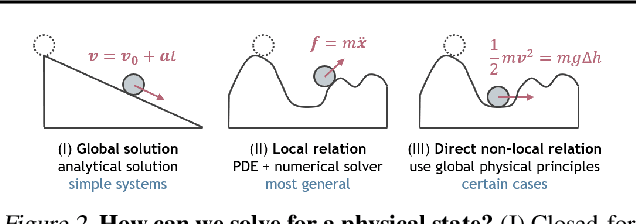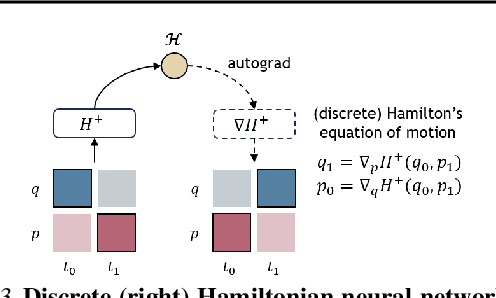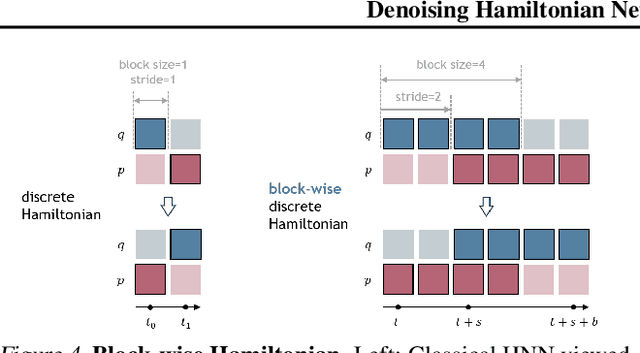Cecilia Garraffo
Center for Astrophysics | Harvard & Smithsonian
Denoising Hamiltonian Network for Physical Reasoning
Mar 10, 2025



Abstract:Machine learning frameworks for physical problems must capture and enforce physical constraints that preserve the structure of dynamical systems. Many existing approaches achieve this by integrating physical operators into neural networks. While these methods offer theoretical guarantees, they face two key limitations: (i) they primarily model local relations between adjacent time steps, overlooking longer-range or higher-level physical interactions, and (ii) they focus on forward simulation while neglecting broader physical reasoning tasks. We propose the Denoising Hamiltonian Network (DHN), a novel framework that generalizes Hamiltonian mechanics operators into more flexible neural operators. DHN captures non-local temporal relationships and mitigates numerical integration errors through a denoising mechanism. DHN also supports multi-system modeling with a global conditioning mechanism. We demonstrate its effectiveness and flexibility across three diverse physical reasoning tasks with distinct inputs and outputs.
Hyperspectral shadow removal with Iterative Logistic Regression and latent Parametric Linear Combination of Gaussians
Dec 24, 2023Abstract:Shadow detection and removal is a challenging problem in the analysis of hyperspectral images. Yet, this step is crucial for analyzing data for remote sensing applications like methane detection. In this work, we develop a shadow detection and removal method only based on the spectrum of each pixel and the overall distribution of spectral values. We first introduce Iterative Logistic Regression (ILR) to learn a spectral basis in which shadows can be linearly classified. We then model the joint distribution of the mean radiance and the projection coefficients of the spectra onto the above basis as a parametric linear combination of Gaussians. We can then extract the maximum likelihood mixing parameter of the Gaussians to estimate the shadow coverage and to correct the shadowed spectra. Our correction scheme reduces correction artefacts at shadow borders. The shadow detection and removal method is applied to hyperspectral images from MethaneAIR, a precursor to the satellite MethaneSAT.
Generating Images of the M87* Black Hole Using GANs
Dec 02, 2023



Abstract:In this paper, we introduce a novel data augmentation methodology based on Conditional Progressive Generative Adversarial Networks (CPGAN) to generate diverse black hole (BH) images, accounting for variations in spin and electron temperature prescriptions. These generated images are valuable resources for training deep learning algorithms to accurately estimate black hole parameters from observational data. Our model can generate BH images for any spin value within the range of [-1, 1], given an electron temperature distribution. To validate the effectiveness of our approach, we employ a convolutional neural network to predict the BH spin using both the GRMHD images and the images generated by our proposed model. Our results demonstrate a significant performance improvement when training is conducted with the augmented dataset while testing is performed using GRMHD simulated data, as indicated by the high R2 score. Consequently, we propose that GANs can be employed as cost effective models for black hole image generation and reliably augment training datasets for other parameterization algorithms.
Simulation-based Inference for Exoplanet Atmospheric Retrieval: Insights from winning the Ariel Data Challenge 2023 using Normalizing Flows
Sep 17, 2023Abstract:Advancements in space telescopes have opened new avenues for gathering vast amounts of data on exoplanet atmosphere spectra. However, accurately extracting chemical and physical properties from these spectra poses significant challenges due to the non-linear nature of the underlying physics. This paper presents novel machine learning models developed by the AstroAI team for the Ariel Data Challenge 2023, where one of the models secured the top position among 293 competitors. Leveraging Normalizing Flows, our models predict the posterior probability distribution of atmospheric parameters under different atmospheric assumptions. Moreover, we introduce an alternative model that exhibits higher performance potential than the winning model, despite scoring lower in the challenge. These findings highlight the need to reevaluate the evaluation metric and prompt further exploration of more efficient and accurate approaches for exoplanet atmosphere spectra analysis. Finally, we present recommendations to enhance the challenge and models, providing valuable insights for future applications on real observational data. These advancements pave the way for more effective and timely analysis of exoplanet atmospheric properties, advancing our understanding of these distant worlds.
 Add to Chrome
Add to Chrome Add to Firefox
Add to Firefox Add to Edge
Add to Edge